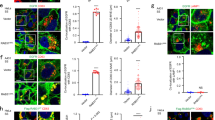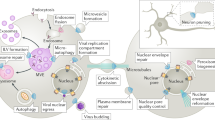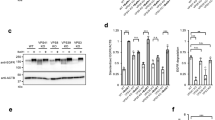Abstract
When internalized receptors and other cargo are destined for lysosomal degradation, they are ubiquitinated and sorted by the endosomal sorting complex required for transport (ESCRT) complexes 0, I, II and III into multivesicular bodies. Multivesicular bodies are formed when cargo-rich patches of the limiting membrane of endosomes bud inwards by an unknown mechanism and are then cleaved to yield cargo-bearing intralumenal vesicles. The biogenesis of multivesicular bodies was reconstituted and visualized using giant unilamellar vesicles, fluorescent ESCRT-0, -I, -II and -III complexes, and a membrane-tethered fluorescent ubiquitin fusion as a model cargo. Here we show that ESCRT-0 forms domains of clustered cargo but does not deform membranes. ESCRT-I and ESCRT-II in combination deform the membrane into buds, in which cargo is confined. ESCRT-I and ESCRT-II localize to the bud necks, and recruit ESCRT-0-ubiquitin domains to the buds. ESCRT-III subunits localize to the bud neck and efficiently cleave the buds to form intralumenal vesicles. Intralumenal vesicles produced in this reaction contain the model cargo but are devoid of ESCRTs. The observations explain how the ESCRTs direct membrane budding and scission from the cytoplasmic side of the bud without being consumed in the reaction.
This is a preview of subscription content, access via your institution
Access options
Subscribe to this journal
Receive 51 print issues and online access
$199.00 per year
only $3.90 per issue
Buy this article
- Purchase on Springer Link
- Instant access to full article PDF
Prices may be subject to local taxes which are calculated during checkout






Similar content being viewed by others
References
Haigler, H. T., McKanna, J. A. & Cohen, S. Direct visualization of the binding and internalization of a ferritin conjugate of epidermal growth-factor in human carcinoma-cells A-431. J. Cell Biol. 81, 382–395 (1979)
Gruenberg, J. & Stenmark, H. The biogenesis of multivesicular endosomes. Nature Rev. Mol. Cell Biol. 5, 317–323 (2004)
Piper, R. C. & Katzmann, D. J. Biogenesis and function of multivesicular bodies. Annu. Rev. Cell Dev. Biol. 23, 519–547 (2007)
Katzmann, D. J., Babst, M. & Emr, S. D. Ubiquitin-dependent sorting into the multivesicular body pathway requires the function of a conserved endosomal protein sorting complex, ESCRT-I. Cell 106, 145–155 (2001)
Babst, M., Katzmann, D. J., Snyder, W. B., Wendland, B. & Emr, S. D. Endosome-associated complex, ESCRT-II, recruits transport machinery for protein sorting at the multivesicular body. Dev. Cell 3, 283–289 (2002)
Babst, M., Katzmann, D. J., Estepa-Sabal, E. J., Meerloo, T. & Emr, S. D. ESCRT-III: an endosome-associated heterooligomeric protein complex required for MVB sorting. Dev. Cell 3, 271–282 (2002)
Bowers, K. & Stevens, T. H. Protein transport from the late Golgi to the vacuole in the yeast Saccharomyces cerevisiae . Biochim. Biophys. Acta 1744, 438–454 (2005)
Morita, E. & Sundquist, W. I. Retrovirus budding. Annu. Rev. Cell Dev. Biol. 20, 395–425 (2004)
Fujii, K., Hurley, J. H. & Freed, E. O. Beyond Tsg101: the role of Alix in ‘ESCRTing’ HIV-1. Nature Rev. Microbiol. 5, 912–916 (2007)
Bieniasz, P. D. The cell biology of HIV-1 virion genesis. Cell Host Microbe 5, 550–558 (2009)
Carlton, J. G. & Martin-Serrano, J. Parallels between cytokinesis and retroviral budding: a role for the ESCRT machinery. Science 316, 1908–1912 (2007)
Morita, E. et al. Human ESCRT and ALIX proteins interact with proteins of the midbody and function in cytokinesis. EMBO J. 26, 4215–4227 (2007)
Samson, R. Y. & Bell, S. D. Ancient ESCRTs and the evolution of binary fission. Trends Microbiol. 17, 507–513 (2009)
Wollert, T., Wunder, C., Lippincott-Schwartz, J. & Hurley, J. H. Membrane scission by the ESCRT-III complex. Nature 458, 172–177 (2009)
Hurley, J. H. ESCRT complexes and the biogenesis of multivesicular Bodies. Curr. Opin. Cell Biol. 20, 4–11 (2008)
Raiborg, C. & Stenmark, H. The ESCRT machinery in endosomal sorting of ubiquitylated membrane proteins. Nature 458, 445–452 (2009)
Lata, S. et al. Helical structures of ESCRT-III are disassembled by VPS4. Science 321, 1354–1357 (2008)
Pires, R. et al. A crescent-shaped ALIX dimer targets ESCRT-III CHMP4 filaments. Structure 17, 843–856 (2009)
Bajorek, M. et al. Structural basis for ESCRT-III protein autoinhibition. Nature Struct. Mol. Biol. 16, 754–762 (2009)
Hanson, P. I., Roth, R., Lin, Y. & Heuser, J. E. Plasma membrane deformation by circular arrays of ESCRT-III protein filaments. J. Cell Biol. 180, 389–402 (2008)
Hanson, P. I., Shim, S. & Merrill, S. A. Cell biology of the ESCRT machinery. Curr. Opin. Cell Biol. 21, 568–574 (2009)
Raymond, C. K., Howald-Stevenson, I., Vater, C. A. & Stevens, T. H. Morphological classification of the yeast vacuolar protein sorting mutants - evidence for a prevacuolar compartment in class-E vps mutants. Mol. Biol. Cell 3, 1389–1402 (1992)
Rieder, S. E., Banta, L. M., Kohrer, K., McCaffery, J. M. & Emr, S. D. Multilamellar endosome-like compartment accumulates in the yeast vps28 vacuolar protein sorting mutant. Mol. Biol. Cell 7, 985–999 (1996)
Doyotte, A., Russell, M. R. G., Hopkins, C. R. & Woodman, P. G. Depletion of TSG101 forms a mammalian ‘class E’ compartment: a multicisternal early endosome with multiple sorting defects. J. Cell Sci. 118, 3003–3017 (2005)
Nickerson, D. P., West, M. & Odorizzi, G. Did2 coordinates Vps4-mediated dissociation of ESCRT-III from endosomes. J. Cell Biol. 175, 715–720 (2006)
Falguières, T. et al. In vitro budding of intralumenal vesicles into late endosomes is regulated by Alix and Tsg101. Mol. Biol. Cell 19, 4942–4955 (2008)
Tran, J. H., Chen, C. J., Emr, S. & Schekman, R. Cargo sorting into multivesicular bodies in vitro . Proc. Natl Acad. Sci. USA 106, 17395–17400 (2009)
Shih, S. C. et al. Epsins and Vps27p/Hrs contain ubiquitin-binding domains that function in receptor endocytosis. Nature Cell Biol. 4, 389–393 (2002)
Bilodeau, P. S., Urbanowski, J. L., Winistorfer, S. C. & Piper, R. C. The Vps27p–Hse1p complex binds ubiquitin and mediates endosomal protein sorting. Nature Cell Biol. 4, 534–539 (2002)
Raiborg, C. et al. Hrs sorts ubiquitinated proteins into clathrin-coated microdomains of early endosomes. Nature Cell Biol. 4, 394–398 (2002)
Mizuno, E., Kawahata, K., Kato, M., Kitamura, N. & Komada, M. STAM proteins bind ubiquitinated proteins on the early endosome via the VHS domain and ubiquitin-interacting motif. Mol. Biol. Cell 14, 3675–3689 (2003)
Bache, K. G., Raiborg, C., Mehlum, A. & Stenmark, H. STAM and Hrs are subunits of a multivalent ubiquitin-binding complex on early endosomes. J. Biol. Chem. 278, 12513–12521 (2003)
Ren, X. & Hurley, J. H. VHS domains of ESCRT-0 cooperate in high-avidity binding to polyubiquitinated cargo. EMBO J 10.1038/emboj.2010.6 (11 February 2010)
Hicke, L., Schubert, H. L. & Hill, C. P. Ubiquitin-binding domains. Nature Rev. Mol. Cell Biol. 6, 610–621 (2005)
Hurley, J. H., Lee, S. & Prag, G. Ubiquitin binding domains. Biochem. J. 399, 361–372 (2006)
Raiborg, C., Bache, K. G., Mehlum, A., Stang, E. & Stenmark, H. Hrs recruits clathrin to early endosomes. EMBO J. 20, 5008–5021 (2001)
Sachse, M., Urbe, S., Oorschot, V., Strous, G. J. & Klumperman, J. Bilayered clathrin coats on endosomal vacuoles are involved in protein sorting toward lysosomes. Mol. Biol. Cell 13, 1313–1328 (2002)
Shields, S. B. et al. ESCRT ubiquitin binding domains function cooperatively during MVB cargo sorting. J. Cell Biol. 185, 213–224 (2009)
Alam, S. L. et al. Ubiquitin interactions of NZF zinc fingers. EMBO J. 23, 1411–1421 (2004)
Katzmann, D. J., Stefan, C. J., Babst, M. & Emr, S. D. Vps27 recruits ESCRT machinery to endosomes during MVB sorting. J. Cell Biol. 162, 413–423 (2003)
Bilodeau, P. S., Winistorfer, S. C., Kearney, W. R., Robertson, A. D. & Piper, R. C. Vps27-Hse1 and ESCRT-I complexes cooperate to increase efficiency of sorting ubiquitinated proteins at the endosome. J. Cell Biol. 163, 237–243 (2003)
Saksena, S., Wahlman, J., Teis, D., Johnson, A. E. & Emr, S. D. Functional reconstitution of ESCRT-III assembly and disassembly. Cell 136, 97–109 (2009)
Im, Y. J., Wollert, T., Boura, E. & Hurley, J. H. Structure and function of the ESCRT-II–III interface in multivesicular body biogenesis. Dev. Cell 17, 234–243 (2009)
Lenz, M., Crow, D. J. G. & Joanny, J. F. Membrane buckling induced by curved filaments. Phys. Rev. Lett. 103, 038101 (2009)
Gill, D. J. et al. Structural insight into the ESCRT-I/-II link and its role in MVB trafficking. EMBO J. 26, 600–612 (2007)
Kostelansky, M. S. et al. Molecular architecture and functional model of the complete yeast ESCRT-I heterotetramer. Cell 129, 485–498 (2007)
Teis, D., Saksena, S. & Emr, S. D. Ordered assembly of the ESCRT-III complex on endosomes is required to sequester cargo during MVB formation. Dev. Cell 15, 578–589 (2008)
Murk, J. L. A. N. et al. Endosomal compartmentalization in three dimensions: implications for membrane fusion. Proc. Natl Acad. Sci. USA 100, 13332–13337 (2003)
Teo, H., Perisic, O., Gonzalez, B. & Williams, R. L. ESCRT-II, an endosome-associated complex required for protein sorting: Crystal structure and interactions with ESCRT-III and membranes. Dev. Cell 7, 559–569 (2004)
Hierro, A. et al. Structure of the ESCRT-II endosomal trafficking complex. Nature 431, 221–225 (2004)
Lee, H. H., Elia, N., Ghirlando, R., Lippincott-Schwartz, J. & Hurley, J. H. Midbody targeting of the ESCRT machinery by a noncanonical coiled coil in CEP55. Science 322, 576–580 (2008)
Angelova, M. I. & Dimitrov, D. S. Liposome electroformation. Faraday Discuss. Chem. Soc. 81, 303–311 (1986)
Acknowledgements
We thank E. Boura for producing the CFP–Ub and GFP–Ub, J. Lippincott-Schwartz for microscope access, B. Wendland for a yeast strain and advice, and W. Prinz for comments on the manuscript. This work was funded by the Intramural Program of the National Institutes of Health, National Institute of Diabetes and Digestive and Kidney Diseases and Intramural AIDS Targeted Antiviral Program to J.H.H. and an EMBO long-term fellowship to T.W.
Author Contributions T.W. carried out all experiments; T.W. and J.H.H. designed experiments and analysed data; and J.H.H. wrote the manuscript.
Author information
Authors and Affiliations
Corresponding author
Ethics declarations
Competing interests
The authors declare no competing financial interests.
Supplementary information
Supplementary Information
This file contains Supplementary Table 1, Supplementary References and Supplementary Figures 1-8 with legends. (PDF 4487 kb)
Rights and permissions
About this article
Cite this article
Wollert, T., Hurley, J. Molecular mechanism of multivesicular body biogenesis by ESCRT complexes. Nature 464, 864–869 (2010). https://doi.org/10.1038/nature08849
Received:
Accepted:
Published:
Issue Date:
DOI: https://doi.org/10.1038/nature08849
This article is cited by
-
Non-bone-derived exosomes: a new perspective on regulators of bone homeostasis
Cell Communication and Signaling (2024)
-
The HIV-1 gag p6: a promising target for therapeutic intervention
Retrovirology (2024)
-
Neural stem cell-derived exosomes and regeneration: cell-free therapeutic strategies for traumatic brain injury
Stem Cell Research & Therapy (2023)
-
Mesenchymal stem cell-derived exosomes in cancer therapy resistance: recent advances and therapeutic potential
Molecular Cancer (2022)
-
Liquid biopsy: Exosomal microRNAs as novel diagnostic and prognostic biomarkers in cancer
Molecular Cancer (2022)
Comments
By submitting a comment you agree to abide by our Terms and Community Guidelines. If you find something abusive or that does not comply with our terms or guidelines please flag it as inappropriate.



